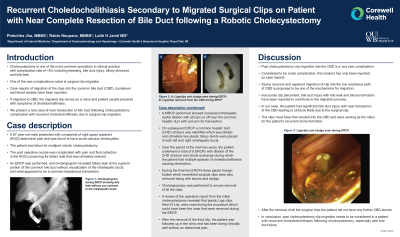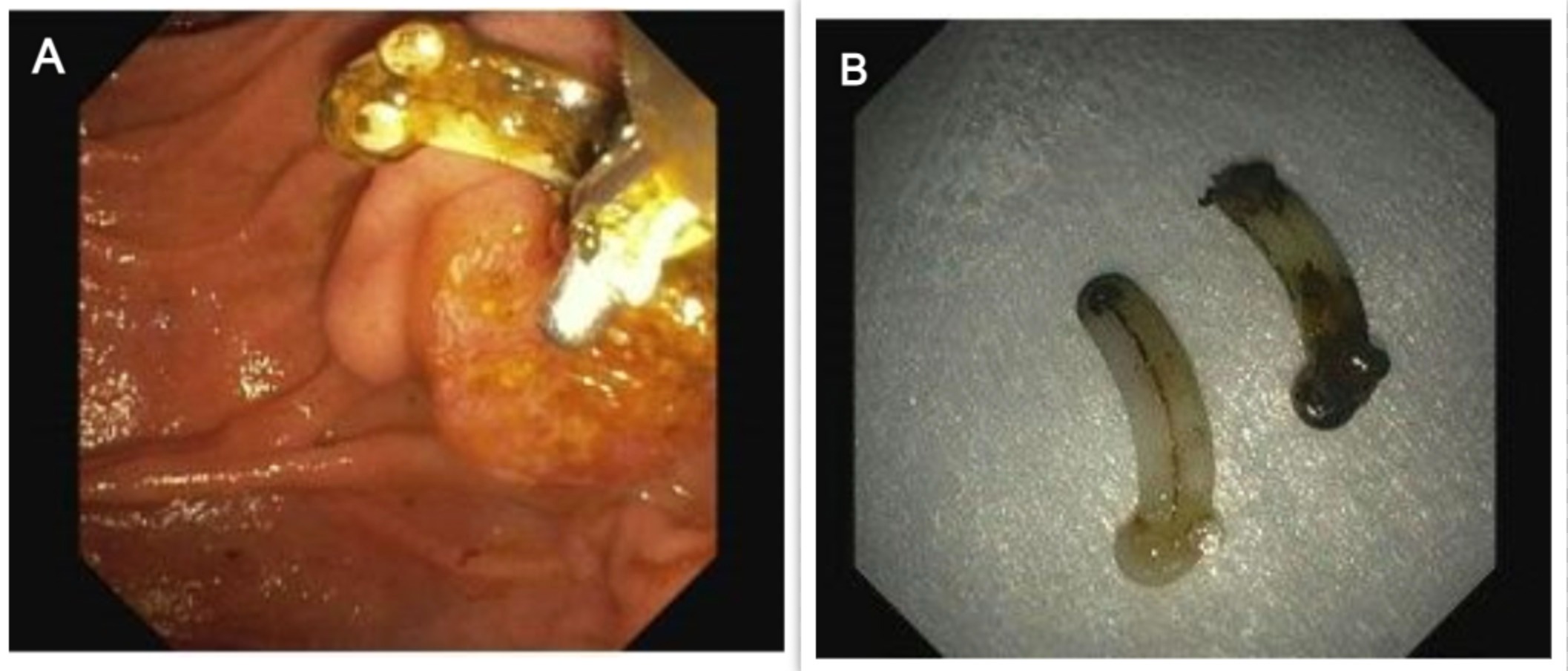Tuesday Poster Session
Category: Interventional Endoscopy
P3761 - Recurrent Choledocholithiasis Secondary to Migrated Surgical Clips in Patient With Near Complete Resection of Bile Duct Following a Robotic Cholecystectomy
Tuesday, October 24, 2023
10:30 AM - 4:00 PM PT
Location: Exhibit Hall

Has Audio
.jpg)
Prekchha Jha, MBBS
Corewell Health
Royal Oak, MI
Presenting Author(s)
Prekchha Jha, MBBS1, Rabin Neupane, MBBS1, Laith H. Jamil, MD, FACG2
1Corewell Health, Royal Oak, MI; 2William Beaumont Hospital-Royal Oak, Royal Oak, MI
Introduction: Cholecystectomy is a common surgery with a low complication rate. However, rare complications such as surgical clip migration can occur. We present a case of near transection of the bile duct following cholecystectomy, complicated by recurrent choledocholithiasis due to surgical clip migration.
Case Description/Methods: Patient is a 67-year-old male who presented with right upper quadrant (RUQ) abdominal pain. Ultrasound abdomen revealed acute calculus cholecystitis for which he had multiport robotic cholecystectomy. Postoperatively, he developed pain and fluid collection in the RUQ concerning for biliary leak. He underwent endoscopic retrograde cholangiopancreatography (ERCP) revealing biliary leak at the superior portion of the common bile duct (CBD)without visualization of the intrahepatic ducts and what appeared to be a near complete transection of common hepatic duct (CHD). A wire could not be passed into the intrahepatic ducts and a plastic stent was placed in the CBD. Magnetic retrograde cholangiopancreatography (MRCP) showed increased intrahepatic ductal dilation with abrupt cut-off near the CHD concerning for transection. The patient was then transferred to our center where successful cannulation of intrahepatic ducts was done via ERCP. CHD stricture was dilated and two plastic biliary stents were placed in both intrahepatic ducts. Over the next two years, he underwent a total of 8 ERCPs with dilation of the CHD stricture and stents exchange. He had recurrent choledocholithiasis which were removed with balloon sweep. However, during the final two ERCPs three plastic foreign bodies resembling surgical clips were also removed. A review of the operative report from the initial cholecystectomy revealed the use of plastic Liga clips, Hem-O-Lok, which could have been the ones that were removed during the ERCP. After the removal of the third clip, he has been doing well without abdominal pain.
Discussion: Clip migration into the common bile duct (CBD) after cholecystectomy is a rare complication. It has only been reported in case reports. Stump necrosis and the low resistance path of the CBD are proposed mechanisms for migration. In this case, near transection of the CBD occurred, leading to a stricture likely caused by a surgical clip. The clips may have eroded into the CBD, acting as a nidus for recurrent stone formation. In conclusion, Postcholecystectomy clip migration should be considered in patients with recurrent choledocholithiasis, particularly in the presence of bile duct injury.

Disclosures:
Prekchha Jha, MBBS1, Rabin Neupane, MBBS1, Laith H. Jamil, MD, FACG2. P3761 - Recurrent Choledocholithiasis Secondary to Migrated Surgical Clips in Patient With Near Complete Resection of Bile Duct Following a Robotic Cholecystectomy, ACG 2023 Annual Scientific Meeting Abstracts. Vancouver, BC, Canada: American College of Gastroenterology.
1Corewell Health, Royal Oak, MI; 2William Beaumont Hospital-Royal Oak, Royal Oak, MI
Introduction: Cholecystectomy is a common surgery with a low complication rate. However, rare complications such as surgical clip migration can occur. We present a case of near transection of the bile duct following cholecystectomy, complicated by recurrent choledocholithiasis due to surgical clip migration.
Case Description/Methods: Patient is a 67-year-old male who presented with right upper quadrant (RUQ) abdominal pain. Ultrasound abdomen revealed acute calculus cholecystitis for which he had multiport robotic cholecystectomy. Postoperatively, he developed pain and fluid collection in the RUQ concerning for biliary leak. He underwent endoscopic retrograde cholangiopancreatography (ERCP) revealing biliary leak at the superior portion of the common bile duct (CBD)without visualization of the intrahepatic ducts and what appeared to be a near complete transection of common hepatic duct (CHD). A wire could not be passed into the intrahepatic ducts and a plastic stent was placed in the CBD. Magnetic retrograde cholangiopancreatography (MRCP) showed increased intrahepatic ductal dilation with abrupt cut-off near the CHD concerning for transection. The patient was then transferred to our center where successful cannulation of intrahepatic ducts was done via ERCP. CHD stricture was dilated and two plastic biliary stents were placed in both intrahepatic ducts. Over the next two years, he underwent a total of 8 ERCPs with dilation of the CHD stricture and stents exchange. He had recurrent choledocholithiasis which were removed with balloon sweep. However, during the final two ERCPs three plastic foreign bodies resembling surgical clips were also removed. A review of the operative report from the initial cholecystectomy revealed the use of plastic Liga clips, Hem-O-Lok, which could have been the ones that were removed during the ERCP. After the removal of the third clip, he has been doing well without abdominal pain.
Discussion: Clip migration into the common bile duct (CBD) after cholecystectomy is a rare complication. It has only been reported in case reports. Stump necrosis and the low resistance path of the CBD are proposed mechanisms for migration. In this case, near transection of the CBD occurred, leading to a stricture likely caused by a surgical clip. The clips may have eroded into the CBD, acting as a nidus for recurrent stone formation. In conclusion, Postcholecystectomy clip migration should be considered in patients with recurrent choledocholithiasis, particularly in the presence of bile duct injury.

Figure: A: Foreign body resembling surgical clips seen in the CBD during ERCP; B: Ligalips, Hem-o-lok, as retrieved after the ERCP
Disclosures:
Prekchha Jha indicated no relevant financial relationships.
Rabin Neupane indicated no relevant financial relationships.
Laith Jamil indicated no relevant financial relationships.
Prekchha Jha, MBBS1, Rabin Neupane, MBBS1, Laith H. Jamil, MD, FACG2. P3761 - Recurrent Choledocholithiasis Secondary to Migrated Surgical Clips in Patient With Near Complete Resection of Bile Duct Following a Robotic Cholecystectomy, ACG 2023 Annual Scientific Meeting Abstracts. Vancouver, BC, Canada: American College of Gastroenterology.
